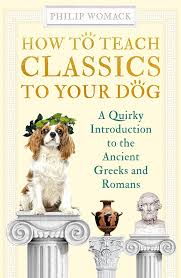How to Teach classics to your dog
An actual book: How to Teach Classics to Your Dog

This book reminds me a bit of Steinbeck’s Travels with Charlie — as you may know, Charlie was Steinbeck’s poodle, and in the book, Steinbeck has conversations with Charlie.
Charley is a tall dog. As he sat in the seat beside me, his head was almost as high as mine. He put his nose close to my ear and said, “Ftt.” He is the only dog I ever knew who could pronounce the consonant F. This is because his front teeth are crooked, a tragedy which keeps him out of dog shows; because his upper front teeth slightly engage his lower lip Charley can pronounce F. The word “Ftt” usually means he would like to salute a bush or a tree. I opened the cab door and let him out, and he went about his ceremony. He doesn’t have to think about it to do it well. It is my experience that in some areas Charley is more intelligent than I am, but in others he is abysmally ignorant. He can’t read, can’t drive a car, and has no grasp of mathematics. But in his own field of endeavor, which he was now practicing, the slow, imperial smelling over and anointing of an area, he has no peer. Of course his horizons are limited, but how wide are mine?
Anyway: How to teach the classics to your dog: you do it via casual conversations, of course, with an emphasis on the role of dogs in the classics in order to maintain your dog’s interest. Here’s a tidbit from near the beginning of the book:
***
A ray of sunshine pierced, spear-like, through the sky, and then the gorgeous bow of Iris, one of the messengers of the gods, appeared.
Una blinked at me, her long, fine lashes quivering in a way that means only one thing: That I’ve made yet another classical reference. …
Iris? she suggested, with a flick of her tail, which waves, flag-like, when she is interested in something, though that is usually a decomposing vole.
“Iris, the rainbow, was a messenger god, along with Hermes. The ancient world, much like ours, was powered by messages. People prayed to the gods and sent curses. Heralds and embassies brought offers of peace or threats of war. In Athenian drama, the speech given by a messenger is one of the dramatic cruxes of the play.” …
We pottered up Parliament Hill, beginning to dry off a little. Una took the opportunity to rub herself on a bit of grass; she only succeeded in making herself look more bedraggled.
“It’s all about messengers,” I continued. “The rainbow is a celestial phenomenon, marveled at by generations. We’ve been trained to think of it as light refracted into seven distinct colours. But look at how Virgil describes Iris in his epic poem, the Aeneid.
Ergo Iris croceis per caelum rosicida pennis
mille trahens varios adverso sole colores
And dewy Iris, on rosy wings, through the sky
Came pulling a thousand colours …
***
And a lot more. This would be a great book to drop on a table in a school library, where students who like dogs might pick it up and flip through it, thus discovering that they might also like the classics.
People make mistakes: the Surpreme Court judge Baroness Hale, when she was awarded her coat of arms, chose for her motto “Omnia Feminae Aequissimae.” The translation given in the press coverage was “Women are equal to all things.” The only problem is, that’s not what it means. It could, just about, mean: “Women are very equal with respect to everything,” but that’s bad Latin. If I saw that in a piece of prose, I’d translate it as “All things of a most equal woman,” which doesn’t make much sense at all. …
Which is funny, and also reminds me of Nicole fixing my Latin and Greek in Silver Circle, after ChatGPT gave me a bad translation for a death spell or whatever.
Anyway, fun book if you’d like to wander through snippets of the classics.
Please Feel Free to Share:






The post How to Teach classics to your dog appeared first on Rachel Neumeier.



